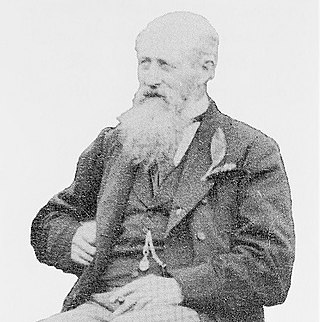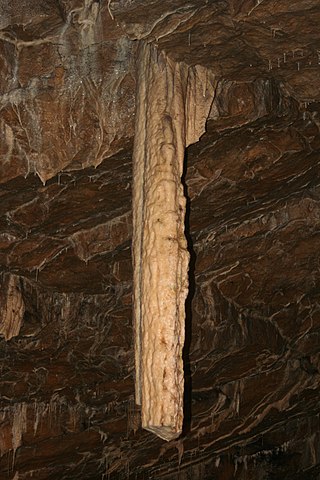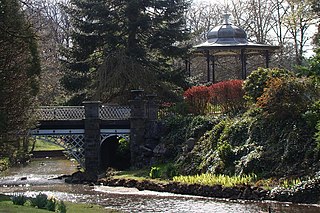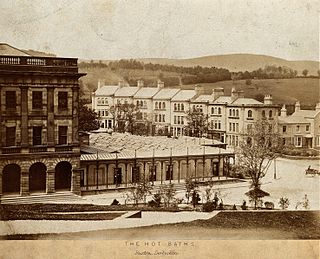William Henry Robertson (15 September 1810 – 15 July 1897) was an English physician and a leading figure behind the development of Buxton as a Victorian spa resort. [1]
Contents

William Henry Robertson (15 September 1810 – 15 July 1897) was an English physician and a leading figure behind the development of Buxton as a Victorian spa resort. [1]

He was born in London and graduated in medicine at the University of Edinburgh in 1830. After practising as a doctor for a short time at Chesterfield, he settled permanently in Buxton, Derbyshire. [2]
William married Eliza Gill in 1836 and they had a daughter Elizabeth and two sons, William and Gordon.
Robertson came to Buxton in 1835. He wrote the definitive tourist guidebook to Buxton in 1854. [3]
He studied the effects of the local mineral waters on disease and promoted their value in the treatment of gout, rheumatism, sciatica, etc. His Guide To The Use Of The Buxton Waters ran to 24 editions. [4]

He was appointed as an honorary physician to the Buxton Bath Charity in 1836 alongside Sir Charles Scudamore. From 1865 he became the chairman of trustees and board of management of the Devonshire Hospital and Buxton Bath Charity.
He was elected as a Fellow of the Royal College of Physicians in 1872.
In 1881, the Buxton Bath Charity trustees (under his chairmanship) persuaded William Cavendish (7th Duke of Devonshire) to give them the use of the whole Devonshire stables building in exchange for providing new stables elsewhere in the town. The clock tower of the Devonshire Dome (by Robert Rippon Duke) was named in his honour.
He lived and practised at No. 6 The Square from 1861 until his death in 1897.
He was chairman of the Buxton Improvements Company and of the trustees of Buxton College. He was also churchwarden at St John the Baptist Church for 30 years.
He qualified as a magistrate in 1867 and served on the bench in Buxton for 30 years.
Robertson Road in Buxton was named after him.

Buxton is a spa town in the Borough of High Peak, Derbyshire, in the East Midlands region of England. It is England's highest market town, sited at some 1,000 feet (300 m) above sea level. It lies close to Cheshire to the west and Staffordshire to the south, on the edge of the Peak District National Park. In 1974, the municipal borough merged with other nearby boroughs, including Glossop, to form the local government district and borough of High Peak.

William Cavendish, 5th Duke of Devonshire,, was a British nobleman, aristocrat, and politician. He was the eldest son of William Cavendish, 4th Duke of Devonshire, by his wife, the heiress Lady Charlotte Boyle, suo jure Baroness Clifford, who brought in considerable money and estates to the Cavendish family. He was invited to join the Cabinet on three occasions, but declined each offer. He was Lord High Treasurer of Ireland and Governor of Cork, and Lord Lieutenant of Derbyshire. In 1782, he was made a Knight of the Order of the Garter.
Peregrine Andrew Morny Cavendish, 12th Duke of Devonshire,, is an English peer. He is the only surviving son of Andrew Cavendish, 11th Duke of Devonshire, and his wife, the former Deborah Mitford. He succeeded to the dukedom following the death of his father on 3 May 2004. Before his succession, he was styled Earl of Burlington from 1944 until 1950 and Marquess of Hartington between 1950 and 2004. His immediate family are owner-occupiers of Chatsworth House and are worth an estimated £905 million. Estates landscaped before 1900 by the family are parts of Derbyshire and North Yorkshire. Other capital managed by the Duke includes fine and contemporary art, forestry and farming.

The University of Derby, formerly known as Derby College, is a public university in the city of Derby, England. It traces its history back to the establishment of the Derby Diocesan Institution for the Training of Schoolmistresses in 1851. It gained university status in 1992.

Robert Rippon Duke was an English architect and surveyor who designed various prominent Victorian buildings in Buxton, Derbyshire.

Poole's Cavern or Poole's Hole is a two-million-year-old natural limestone cave on the edge of Buxton in the Peak District, in the county of Derbyshire, England.

White Watson was an early English geologist, sculptor, stonemason and carver, marble-worker and mineral dealer. In common with many learned people of his time, he was skilled in a number of artistic and scientific areas, becoming a writer, poet, journalist, teacher, botanist and gardener as well as a geologist and mineralogist. He kept extensive diaries and sketchbooks of his observations on geology, fossils and minerals, flora and fauna, and published a small but significant and influential number of geological papers and catalogues. As an artist he was well known locally for his silhouettes, both on paper and as marble inlays.

Henry Currey (1820–1900) was an English architect and surveyor.

The Devonshire Dome building is a Grade II* listed 18th-century former stable block in Buxton, Derbyshire. It was built by John Carr of York and extended by architect Robert Rippon Duke, who added what was then the world's largest unsupported dome, with a diameter of 44.2 metres (145 ft). It is now the site of the Buxton Campus of the University of Derby.

The Old Hall Hotel is a hotel in Buxton, Derbyshire, England, and is one of the oldest buildings in the town. The current building dates from the Restoration period, built around and incorporating an earlier fortified tower.

Ashford Black Marble is the name given to a dark limestone, quarried from mines near Ashford-in-the-Water, in Derbyshire, England. Once cut, turned and polished, its shiny black surface is highly decorative. Ashford Black Marble is a very fine-grained sedimentary rock, and is not a true marble in the geological sense. It can be cut and inlaid with other decorative stones and minerals, using a technique known as pietra dura.

Buxton Crescent is a Grade-I-listed building in the town of Buxton, Derbyshire, England. It owes much to the Royal Crescent in Bath, but has been described by the Royal Institution of British Architects as "more richly decorated and altogether more complex". It was designed by the architect John Carr of York, and built for the 5th Duke of Devonshire between 1780 and 1789. In 2020, following a multi-year restoration and redevelopment project supported by the National Heritage Memorial Fund and Derbyshire County Council, The Crescent was reopened as a 5-star spa hotel.
Sir Charles Scudamore (1779–1849) was an English physician, known for his writings on gout.

The Devonshire Royal Hospital was established as the Devonshire Hospital in 1859 in Buxton, Derbyshire by the Buxton Bath Charity for the treatment of the poor. The hospital was built in the converted stable block of The Crescent. The building is now known as the Devonshire Dome and it is the site of the Buxton Campus of the University of Derby.

Buxton Pavilion Gardens is a Victorian landscaped public park in the spa town of Buxton in Derbyshire. The River Wye flows through the gardens, which are a Grade II* listed public park of Special Historic Interest.

The Square is a Grade-II*-listed building in Buxton, Derbyshire, England. It lies in the town's central Conservation Area immediately between The Crescent, the Old Hall Hotel, the Pavilion Gardens and the Buxton Opera House.

The Slopes is a Grade-II-listed public park in Buxton, Derbyshire in England. The area was laid out by landscape architect Jeffry Wyatville in 1811 for William Cavendish, 6th Duke of Devonshire, as pleasure grounds for the guests of The Crescent hotel to promenade. The design of The Terrace was modified further by Sir Joseph Paxton in 1859.

St Ann's Well is an ancient warm natural spring in Buxton, Derbyshire in England. The drinking well is located at the foot of The Slopes and opposite the Crescent hotel and the Old Hall Hotel.

Buxton Town Hall was opened in 1889 on the Market Place in Buxton, Derbyshire, England. It lies in the town's central Conservation Area overlooking The Slopes. It is a Grade-II-listed building.

The Buxton Baths using natural thermal spring water are in Buxton, Derbyshire, England. The baths date back to Roman times and were the basis for developing Buxton as a Georgian and Victorian spa town. The present buildings of the Thermal Baths and the Natural Mineral Baths were opened in the 1850s. They are positioned either side of the Buxton Crescent at the foot of The Slopes in the town's Central Conservation Area. They are both Grade II listed buildings designed by Henry Currey, architect for the 7th Duke of Devonshire.